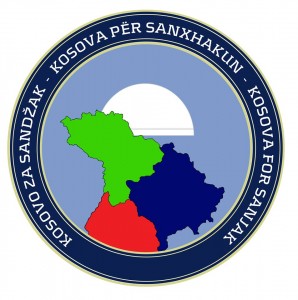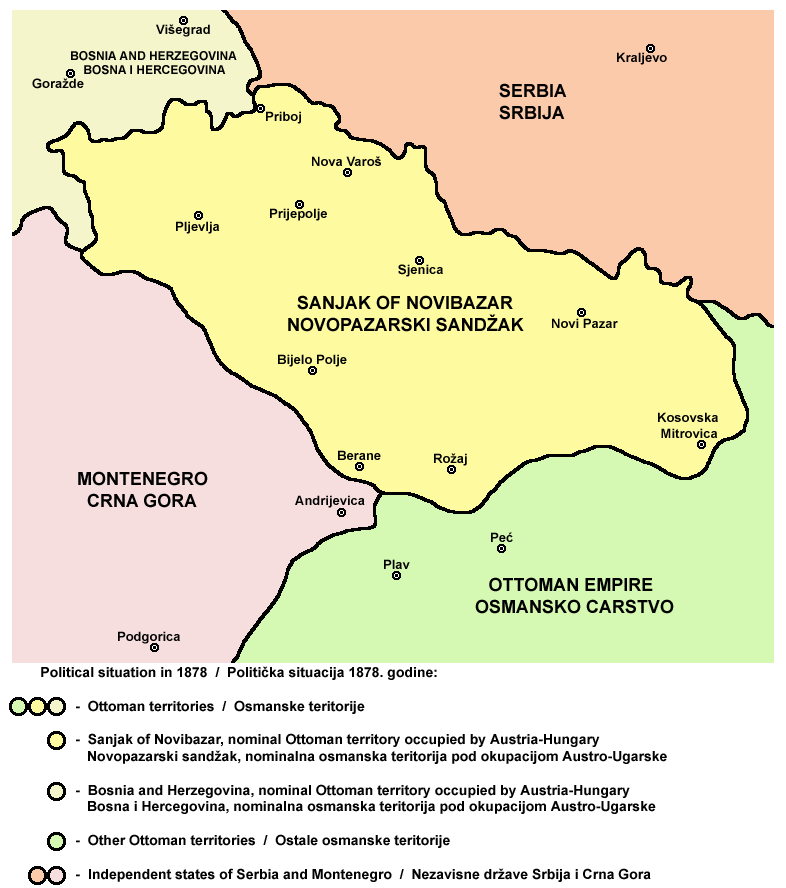In 1877, Ottoman Turkey created the Vilayet or province of Kosovo, or “Kossovo”, in European Turkey or Turkey in Europe, which consisted of the sandzak or district of Skopje, or Uskub, in Macedonia, and the sandzaks of Prizren in Kosovo and Novi Pazar in the Sandzak or Rashka region of Serbia. The Kosovo vilayet was a product of the 1864 Ottoman Turkish law that reorganized the standard provincial administration throughout the Ottoman empire. The eyalets, the Turkish provinces, were restructured as smaller vilayets under a governor or a vali. The valis were appointed by the Turkish government. New provincial assemblies, however, were allowed to participate in the administration. The vilayets were subdivided into sandzaks or districts headed by a bey or beg.
The Albanian leaders of the 1878 League of Prizren, when the Greater Albania ideology was formulated, demanded that Turkey attach or annex the vilayet of Kosovo to a Greater Albania. The Ottoman Turkish government rejected the creation of a Greater Albania, which resulted in an Albanian insurgency to expel the Turks and to create a Greater Albania on their own.
|
The British Consul in Albania, Sir William Kirby-Green, described the Prizren League in an 1880 report as follows: “[T]he Albanian League is an organization of the most fanatical Muslims in the country. Those people are now taken up with extreme religious fanaticism and hatred of Christians. With the exception perhaps of Mecca, Prizren is the most dangerous spot for a Christian to be in all Mohammedan countries.” The goal to create a Greater Albania failed when Turkish military forces put down the rebellion. The Greater Albania ideology, however, endured and evolved.
Isa Boletini or Iso Boljetinac (1864-1916), was a “Kosovar” Albanian ultra-nationalist who waged a long-standing battle to create a Greater Albania consisting of Kosovo-Metohija and Illirida. Boletini was born in the northern Kosovo village of Boletin, near Kosovska Mitrovica. Boletini was a committed Albanian nationalist who sought to implement the Greater Albania ideology through force. The 1878 Prizren League had the goal to create a Greater Albania out of the Kosovo vilayet, which would entail the annexation of Kosovo-Metohija and Western Macedonia, or Illirida, to a Greater Albania.
Boletini was an ideologue of the 1878 League of Prizren. He wanted to advance the primary political goals of the Prizren League to unite the four Ottoman Turkish vilayets with an Albanian population into a united Greater or Ethnic Albania. Boletini joined the Albanian Prizren League forces at the age of 17, and fought in the battle of Slivovo valley in central Kosovo against the Ottoman Turkish forces to establish a Greater Albania by military force. Boletini had a life-long commitment to the creation of a Greater Albania. As a Kosovar, his primary goal was to achieve the annexation of Kosovo-Metohija to Albania.
|
||||
Boletini openly advocated the genocide, expulsion, and ethnic cleansing of the Kosovo Serb population. In 1913, when leaving the Ambassador’s Conference in London, Boletini stated: “When spring comes, we will manure the plains of Kosovo with the bones of Serbs, for we, Albanians, have suffered too much to forget.” This is an open call for the genocide of Kosovo Serbs. Boletini, the political and military leader of Kosovo Albanians, and himself a so-called Kosovar, announced openly a plan for the ethnic cleansing and expulsion and genocide of the Kosovo Serb population. This open advocacy of genocide is ignored and covered-up by Greater Albania ultra-nationalists and their supporters, such as Canadian Robert Elsie, who is one of the key propagandists of a Greater Albania. Elsie studied in West Germany and worked for the German Ministry of Foreign Affairs from 1982 to 1987 in Bonn. A so-called Albanian specialist, Elsie has written extensively in support of a Greater Albania that would include the Serbian province of Kosovo-Metohija. Instead, they focus on the alleged statements made by Belgrade university professor Vaso Cubrilovic, a Bosnian by birth, for the expulsion of Albanians.
In fact, it was Boletini who announced openly the plan of the Kosovar Albanian political leaders for the expulsion and genocide of Kosovo Serbs. Boletini regarded talk as cheap. For Boletini, borders were created from the end of a barrel of a gun. He didn’t waste his time with academic “memorandums”.
In August, 1912, his forces took over Skopje, the capital of the Kosovo vilayet, pursuant to his plans to annex Western Macedonia to Albania. Boletini created a Greater Albania. He demanded the creation of a Greater Albania and diplomatic recognition. During World War I, he was a proxy for Austria-Hungary and Germany and joined the terrorist, separatist Kachak movement to make Kosovo and Western Macedonia a part of a Greater Albania. He was killed on January 23, 1916 by Montenegrin forces when he tried to seize Podgorica, the capital of Montenegro, as a proxy for the Austro-Hungarian army, which was the major sponsor of a Greater Albania at that time.
In 1905, the population of the Kosovo vilayet was approximately 1,100,000. The total area of the vilayet was 12,700 sq. m. The population consisted of Serbs, Bulgarians, Macedonians, Albanians, Greeks, Turks, Vlachs, and Roma. There were good roads that ran through Skopje and a railway from Salonika that ran north and divided at Skopje, the capital of the vilayet. One branch traversed to Kosovska Mitrovica and the other to Nis in Serbia. The vilayet was rich in minerals and there were many mines. In 1907, there were two chrome mines in the vilayet, at Orasje and Verbestica, near Strpce in southern Kosovo.
The capital of the Kosovo vilayet was Skopje, which had a population of 32,000. at that time. Prizren in Kosovo had a population of 30,000, Veles or Koprulu in Turkish, 22,000, Stip or Ishtip in Turkish, 21,000, Novi Pazar 12,000, and Pristina 11,000.The Kosovo vilayet was one of the most productive agricultural regions of the Ottoman Empire. The exports from the Kosovo vilayet consisted chiefly of livestock, fruit, grain, tobacco, vegetables, opium, hemp and skins. The value of the exports was 950,000 pounds. Rice was grown primarily for domestic consumption. Two-thirds of exports and imports from the Kosovo vilayet passed through Salonika; one-third was with Serbia, where goods were transported by railway.
In the medieval period, the area encompassed in the vilayet formed part of the Serbian state, the northern districts known as Old Serbia, or Stara Srbija. The plain of Kosovo, Kosovo Polje, “Field of Blackbirds “, is a long valley which is located west of Pristina. The Sibnica River, a tributary of the Ibar River, flows into the Kosovo Polje Valley.



